ISLAND DISPUTES BETWEEN VIETNAM AND CHINA
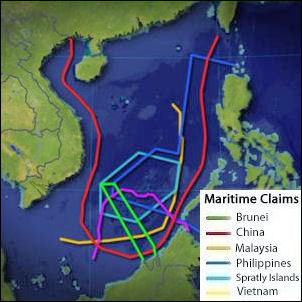
In 1974, during the Vietnam War, the Chinese military drove South Vietnamese troops out of the Paracel Islands, which are claimed by Beijing and Hanoi. The last fighting in the South China Sea, involving China and Vietnam, killed more than 70 Vietnamese sailors in 1988. The armed conflict that erupted in 1988 over the Spratly Islands left more than 100 Vietnamese and Chinese troops killed or missing. The Chinese navy sunk two Vietnamese boats and 70 men were lost in a clash over the Spartly islands.
Jim Holmes wrote in Foreign Policy, “Beguiled by undersea oil and gas deposits and the weakness of fellow claimants to the Paracel Islands, China launched a naval offensive to seize the disputed archipelago. To justify its actions, Beijing pointed to history -- notably Ming Dynasty Adm. Zheng He's visits to the islands in the 15th century -- while touting its "indisputable sovereignty" over most of the South China Sea. [Source: Jim Holmes, Foreign Policy, July 26, 2012]
Chinese vessels carrying amphibious troops and operating under fighter cover from nearby Hainan Island engaged a South Vietnamese flotilla bereft of air support. One Vietnamese destroyer escort lay at the bottom of the South China Sea following the daylong battle. China's flag fluttered over the islands. The skirmish was real -- and the date was Jan. 17, 1974.
History may not repeat itself exactly, but it sure rhymes. Back then, China exploited South Vietnamese weakness to seize the Paracels. Now, the People's Liberation Army (PLA) has announced plans to station a military garrison at Sansha, a newly founded city on the 0.8 square-mile Woody Island in the Paracels. Formally established on July 24, Sansha will act as China's administrative center for the Paracel and Spratly islands and adjoining waters.
The Paracel Islands south of Hainan in the northern part of the South China are also contested by Vietnam and China. Vietnam has been angered by efforts by China to develop tourism on the islands. About 2,000 well-heeled Chinese tourists visits the main island of Yunghsing a year on military and government vessels to enjoy water sports and tropical scenery. Vietnam also offers sightseeing trips to the island.
In 2000, Vietnam and China signed two agreements to resolve a long-standing territorial dispute over the resource rich Gulf of Tonkin. The agreement demarcated territorial waters and exclusive economic zones and outlined fisheries cooperation. In 1999, the two countries signed a land border agreement after 20 rounds of negotiations.
In 2007, China’s National People’s Congress created a symbolic administrative region called Sansha to administer the Spratly and Paracel Islands. Vietnam was not very happy about that. In April 2007, four Vietnamese fishing boats were detained by China in the disputed Spratly archipelago of the South China Sea. In July 2007, a Vietnamese fishing boat sank after being rammed by a Chinese vessel. One Vietnamese fisherman died. [Source: Edward Wong, New York Times, October 5, 2010]
Vietnam-China Island Dispute in 2011
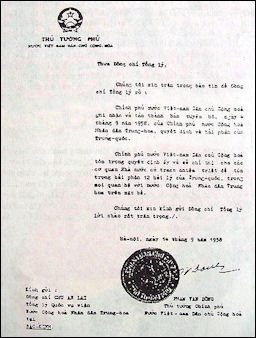
diplomatic note from
pham van dong to zhouenlai Vietnam says Chinese boats have hindered oil exploration within its economic exclusive zone, 300 kilometers off the coast. In May and June, Vietnam accused Chinese maritime vessels of harassing and intentionally damaging equipment being towed by Vietnamese ships operating within Vietnam's exclusive economic zone in the South China Sea. In May 2011 Vietnam accused China of slicing cables from an oil survey ship. China denied that its ships had done anything wrong. Beijing accuses Vietnam of endangering Chinese fishermen in a contested area near the Spratly islands, which are claimed all or in part by both countries and several other Asian nations.
In June 2011, Vietnam accused Chinese ships of ramming a Vietnamese an oil survey ship cutting the exploration cables of another ship. On the case of the latter a Chinese fishing boat supported by two patrol vessels had damaged the exploration cable of a state-operated seismic survey boat off the central Vietnamese coast. Vietnam said it was the second time China had hindered the operation of an oil and gas exploration boat in two weeks, adding that its actions were "completely premeditated" and accusing it of flaring regional tensions in the South China Sea. Hanoi says both incidents occurred well within the 200 nautical miles guaranteed to Vietnam as an exclusive economic zone by international law. [Source: AP, June 10, 2011]
China demanded that Vietnam stop "all invasive activities" after accusing it of illegally entering its waters and endangering Chinese fishermen's lives in an escalating dispute over territory in the South China Sea. In the statement, ministry spokesman Hong Lei said the Chinese fishing boat crew had instead been in waters around the Spratly Islands, which are claimed by China and Vietnam and some other Asian nations. He said the crew had merely been protecting itself after being dragged backward for over an hour by a Vietnamese oil and gas exploration vessel - one, he said, that was "illegally working at the scene." "The claims made by Vietnam are complete misrepresentations of the truth.
“As is known to all, China has indisputable sovereignty rights over the Spratly Islands and the waters nearby," Hong said. "It needs to be pointed out that in illegally exploring for oil and gas and forcing out Chinese fishing boats from the Wan'an bank of the Spratly Islands, Vietnam has seriously violated China's sovereignty and maritime rights," he said.
Vietnam is buying Russian submarines and hosting visits by the U.S. Navy. In mid June China staged military exercises and Vietnam held live ammunition drills in the disputed area of the South China Sea. Around the same China launched a large naval surveillance ship the region and said it wold beef up its coastal forces by adding additional ships and 6,000 personnel y 2020. Later the two nations conducted joint naval patrols in the Gulf of Tonkin with China.
China plans to eventually deploy an aircraft carrier in the South China Sea, while Vietnam is preparing to have its Russian-made submarines prowl the waters. Former Vietnam Border Committee Chairman Tran Cong Truc said China was testing Vietnam's reaction to the recent flareup, and warned China would become more aggressive in the South China Sea if Vietnam sat idly by. [Source: Yomiuri Shimbun]
China has voiced its displeasure with India for forming a partnership with Vietnam to search for oil in the South China Sea. The areas being explored re well within Vietnam’s territorial waters. In August 2011, a China warship confronted an Indian naval vessel in waters off Vietnam demanding it identify itself.
Anti-Chinese Protests in Vietnam in 2011
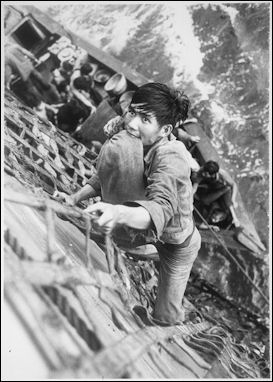
Vietnamese refugee The anti-China demonstrations started after the Vietnamese government made public a case in late May in which it said Chinese patrol ships harassed a Vietnamese seismic survey ship operating in Vietnamese waters. Demonstrations are rare and normally snuffed out swiftly in Vietnam. Similar anti-China protests in Ho Chi Minh City, which drew more than 1,000 people, were shut down by police in June.
Protesters in Hanoi marched for four straight weeks in June 2011 to voice their outrage at their country's more powerful neighbor. In one demonstration about 100 protesters marched down humid streets carrying signs that read: "China stop lying. China stop invading" and "Stop violating the territorial waters of Vietnam." Protests are extremely rare in communist Vietnam and are typically quashed quickly by security forces. Still, Hanoi has allowed the demonstrations to go on for the past four Sundays amid tight security. [Source: AP, June 26, 2011]
Junichi Fukasawa and Makiko Yanada wrote in the Yomiuri Shimbun: “In Hanoi and Ho Chi Minh City, Vietnam's biggest city, hundreds of protesters vented their anger in front of Chinese diplomatic missions Sunday. Holding up signs with such messages as "China must stop acts of aggression!" the crowds boisterously chanted anti-China slogans under a heavy security presence. A university student who joined the protest in Hanoi said he had heard about the demonstration on the Internet. "I came here to lash out at China," he said. One message online said, "We have driven aggressors out of our country many times...and all generations should take up arms [to fight Chinese aggression]." [Source: Junichi Fukasawa and Makiko Yanada, Yomiuri Shimbun, June 16, 2011]
“Under the Vietnamese Communist Party, street demonstrations unauthorized by the government are strictly banned--as they are in China. Vietnamese authorities this time, however, apparently gave tacit approval to the protests. The outpouring of anger comes at a time of high inflation in Vietnam. Prices of food and other goods have risen about 15 percent since the beginning of the year, stirring discontent among the people. The Vietnamese government appears to have calculated this dissatisfaction could shake the regime's foundations, and could be heightened if it took a conciliatory stance toward China that might inflame nationalistic feelings among the people. Vietnam and China both face simmering discontent due to widening economic disparities among their populace. The confrontational stances taken by Vietnam and China toward each other appears to be the flipside of their domestic situations.”
Hanoi Cracks Down on Anti-Chinese Protests
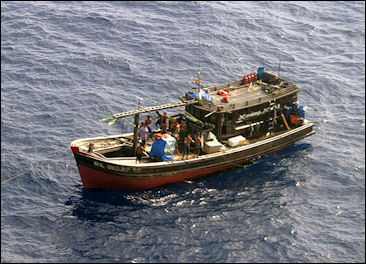
Vietnamese vessel In mid July 2011, AP reported security forces in Vietnam forcibly broke up an anti-China rally in Hanoi by detaining protesters and journalists covering the event. As soon as protesters gathered within sight of the Chinese embassy in Vietnam’s capital, police herded them onto buses, along with journalists and cameramen recording the rally.Authorities have allowed the rallies on five previous Sundays in a row. The move to crack down on the protests comes two weeks after officials from Vietnam and China met in Beijing and said they had agreed to negotiate to peacefully resolve a territorial dispute in the South China Sea. [Source: AP July 14, 2011]
In early August 2011, Reuters reported, Anti-China demonstrators staged another in a series of weekly marches in central Hanoi on Sunday, testing authorities' tolerance of protests on an emotive issue in Vietnamese society. Up to 200 people singing patriotic songs, carrying banners and flags and chanting slogans drew stares from bemused tourists and honks of approval from motorists as they filed around Hoan Kiem Lake. [Source: John Ruwitch, Reuters, August 7, 2011]
But the Hanoi rallies have been staged for nine of the last 10 weeks, despite two weekends in July when police detained several protesters and journalists. "This has become a regular thing. In the minds of the people who come out to do this it's like having a meal or drinking water," said Nguyen Quang Thach, a regular at Hanoi protests. Traffic police redirected cars and motorcycles past the demonstration. Plainclothes police followed the protesters and filmed the procession.
The apparent attempt by police to forcibly end the demonstrations backfired when video on YouTube of a demonstrator being kicked in the face by an undercover policeman while being hauled onto a bus sparked an outcry online. Protesters have tried hard not to antagonise the police by sticking to their anti-China message, staying on the sidewalk and remaining far from the Chinese embassy. "When the problem of the Sea is solved, when we find some just solution, then there is no reason for demonstrations anymore," said Nguyen Quang A, an economic analyst and retired businessman who attended the demonstration.
In late August 2011, Reuters reported, “Vietnamese police detained scores of people taking part in an anti-China rally in Hanoi in defiance of a government order to end a string of demonstrations that has stretched three months and put authorities on edge. One witness said plainclothes police forced around 40 demonstrators onto two public buses and drove them away within minutes of the start of the demonstration. A blogger who has chronicled the demonstrations and has contacts among the regular protesters said at least one bus left with 19 people aboard. It was the 11th anti-China rally in an unprecedented series of public protests that have taken place nearly every Sunday since early June against what Vietnamese see as China's violations of their country's sovereignty in the South China Sea.[Source: Reuters, August 21, 2011]
"We're very concerned that protesters were arrested by the police and call for their immediate release," said Phil Robertson, deputy head for Asia of Human Rights Watch. "Sadly, the over-reaction of the authorities was shown by the fact that the police outnumbered the protesters, and their aggressive actions to prevent the assembly from going forward. These protesters have done nothing wrong, the police should release them unconditionally."
A few days earlier the Hanoi city government had issued an order to end "gatherings, demonstrations and spontaneous marches" and threatened to take "necessary measures" against those who defy the order. In response, 25 prominent intellectuals and others connected to the demonstrations wrote a petition to the Hanoi People's Committee saying the order was unconstitutional. The letter was posted online. The Hanoi government notice said the protesters were interfering with diplomatic efforts in the dispute with China.
The demonstrations have so far not exceeded 300 people, but Vietnam's Communist Party brooks no opposition and analysts say it is nervous about Arab-style protests against autocratic rule. The blogger, Nguyen Xuan Dien, said police had several people in recent days to urge them to refrain from participating in the protests. Another activist who declined to be identified said "scores" of people had been confined to their homes or otherwise hindered from attending the protests.
Hanoi Cracks Down on Anti-Chinese Criticism by Journalists and Bloggers
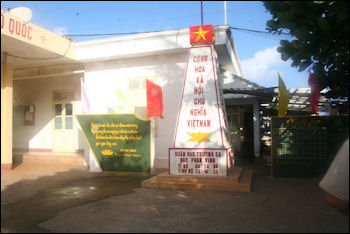
Dao Phan Vinh In August 2011, Time magazine reported: “Hanoi is stepping up pressure on its critics, detaining one Vietnamese journalist and two Vietnamese bloggers this past week after they wrote provocative reports that questioned China's territorial aims. Though there have been no official announcements about the charges, all were allegedly arrested for violating "national security." [Source: Martha Ann Overland, Time, September 5, 2009]
The latest arrest took place early morning on Sept. 3 when police detained blogger Nguyen Ngoc Nhu Quynh, 30, at her home in the coastal city of Nha Trang. Quynh's mother said that plainclothes police had been watching the house for several months, ever since her daughter had started criticizing Vietnam for giving China the green light to mine its vast stores of bauxite, a mineral needed to process aluminum, on her blog. "The warrant said my daughter was arrested under Article 258 of the Criminal Code for abusing democratic freedoms to infringe upon the state's interests," said an emotional Nguyen Thi Tuyet Lan, Quynh's mother. "They searched her house until 3:30 that morning and then put her in a van that disappeared into the quiet of the night." The family has not heard from her since.
On Sept. 3, the New York-based Committee to Protect Journalists criticized Vietnam's recent crackdown on journalists and political bloggers, whose "independent reporting challenges the tightly censored state-run media's traditional monopoly on local news and opinion." But it's not exactly a surprise. The Vietnamese government has long been extremely sensitive about its relationship with neighboring China. The two nations have battled for centuries, last going to war in 1979 when Beijing sent troops into Vietnam to punish Hanoi for ousting the Khmer Rouge in Cambodia and installing a Vietnamese-backed government. Today, China is a huge trading partner and investor in Vietnam — providing cash that the country desperately needs. (See pictures of the China-Vietnam border war.)
The blogger's arrest follows the detention of two other writers. On Aug. 27, a blogger named "Wind Trader", whose real name is Bui Thanh Hieu, accused the Communist Party of rolling over when it came to China on his blog, and was also critical of the government's handling of the controversial mining project and its territorial disputes with Beijing. A day later, authorities arrested Pham Doan Trang, a 31-year-old journalist working for VietnamNet, a reform-leaning, online website, which, like all domestic media in Vietnam, including blogs, is under the control of the government. Trang covered the long-running boundary dispute between China and Vietnam in the South China Sea. Access to several of her articles on VietnamNet are now blocked.
It's not clear what work Trang was arrested for. Like many young Vietnamese, Trang also had a blog. Her last posting was in May, where she discussed the controversial bauxite mining plan that was being debated by the National Assembly. Her single entry that month contained fairly innocuous remarks, mentioning only that the government had hastily prepared their report on the bauxite project. Nguyen Anh Tuan, the editor of VietnamNet has said that all he knew was that his reporter was arrested for violating national security, insisting that these alleged crimes were not related to her VietnamNet stories. Tuan has heard nothing from Trang since her arrest, nor does he know where she is being held. "We have to wait now."
Vietnam, China to Try Resolve South China Sea Dispute
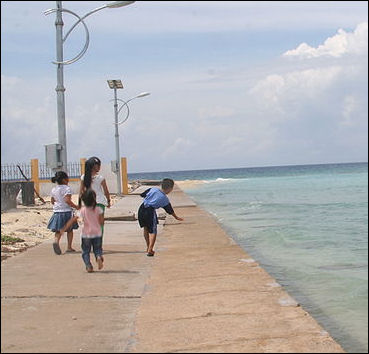
Truong Sa lon China and Vietnam have agreed to speed up negotiations towards ending a long-running spat over the South China Sea, state media reported on Thursday, as Beijing continued a campaign to defuse tension. In Hanoi, China's top foreign affairs official, State Councilor Dai Bingguo, co-chaired closed-door discussions this week, which analysts see as paving the way for a visit to China by Vietnam's new Communist Party chief Nguyen Phu Trong, possibly later this year.
The two sides "agreed to intensify the efforts to speed up the negotiation and work out a mutually agreeable solution on the issue, and pledged to work hard to sign an agreement as early as possible", China's Xinhua news agency reported. [Source: Reuters, September 8, 2011]
Vietnamese Prime Minister Nguyen Tan Dung, who met Dai said differences of opinion over what Vietnam calls the East Sea were an objective fact, and the two sides needed "to hasten negotiations to sign an agreement on basic principles" for settling the dispute, the Vietnam News reported.
A big sticking point between China and the other claimants is Beijing's insistence on settling differences on a bilateral basis rather than in a multilateral forum. "There are many facets to the East Sea issue and we think bilateral problems should be resolved bilaterally but multilateral problems must be resolved multilaterally," Vietnamese Foreign Ministry spokeswoman Nguyen Phuong Nga told a news conference.
China Plans Garrison to “Defend” Disputed Paracel Islands
Jim Holmes wrote in Foreign Policy, “In June 2012, the Chinese government established "Sansha City" on Woody Island in the Paracel chain, which China seized from South Vietnam in 1974. Sansha will be the administrative center for China's claims in the South China Sea, to include the Spratly Islands near Reed Bank and Palawan, and Scarborough Shoal. China also announced plans to send a military garrison to the area, saying it had begun "combat-ready" patrols in waters it said were under its control in the South China Sea, after saying it "vehemently opposed" a Vietnamese law asserting sovereignty over the Paracel and Spratly islands. [Source: Jim Holmes, Foreign Policy, July 26, 2012]
In July 2012, AFP and Reuters reported: “Beijing will establish a military garrison on a group of disputed islands in the South China Sea, the Chinese Ministry of Defense said, a move likely to provoke further tensions with its neighbors. The troops will operate from Sansha in the Paracel Islands (Xisha Islands), one of two archipelagos in the South China Sea that are claimed by both China and Vietnam. The garrison, approved by the Central Military Commission, “will be responsible for the Sansha area national defense mobilization and reserve forces activities,” the Chinese Ministry of Defense said on its Web site. [Source: AFP and Reuters, July 24, 2012]
The ministry did not say when the garrison would be established, but the move to station troops on the Paracels is likely to provoke Hanoi’s ire. Beijing’s move in June to designate Sansha as its administrative center for the Paracels and the Spratly Islands (Nansha Islands) prompted a rare demonstration in Hanoi. China and South Vietnam once administered different parts of the Paracels, but after a brief conflict in 1974, Beijing took control of the entire group of islands. Vietnam holds several of the larger Spratly Islands.
Vietnam Hold Anti-China Rally After Plans for Garrison Are Announced
In July 2012, AFP reported: “About 200 protesters brought parts of central Hanoi to a brief halt in the third rally this month against Beijing's perceived territorial assertiveness in the South China Sea. Demonstrators shouting "Down with China's aggression!" brought traffic around Hoan Kiem Lake in the centre of the Vietnamese capital to a standstill as they marched towards the Chinese embassy. They were prevented from getting close to the mission building by security forces -- who broke up similar rallies last year -- but no arrests were made, according to witnesses. [Source: AFP, July 22, 2012]
The protests come at a time of rising regional tensions over the South China Sea, which is believed to contain vast oil and gas deposits and is the subject of a web of competing claims between Beijing and its neighbours. Relations between the pair have soured recently, with Vietnam attracting China's ire in June after it adopted a law that places the Spratlys under Hanoi's sovereignty. China's state-backed China National Offshore Oil Corp. also said it was seeking bids for exploration of oil blocks in disputed waters -- a move slammed by Vietnam.
China’s Plan to Open the Paracels to Tourism
In April 2012, Reuters reported: “China plans to let tourists visit the disputed Paracel Islands in the South China Sea, according to official comments reported that could add another irritant to Beijing's maritime tensions with Vietnam and other neighbours. "The broad plan is being worked on, and a specific one is also being worked on, and we hope that within the year we'll be able to open maritime tourism to the Paracel Islands," said Deng Xiaogang, a deputy head of tourism for Hainan, the southern Chinese island-province that is near the disputed islands. [Source: Reuters, April 5, 2012]
Deng's comments were first reported by Chinese state radio and later widely reported by Chinese media, including the China News Service. Wang Zhifa, a deputy head of China's national tourism authority, said in March that "developing tourism in the Paracel islands will help us to protect our frontiers and demonstrate the existence of our sovereignty", said the news report.
In March 2012, China and Vietnam quarreled after Beijing said it had detained 21 Vietnamese for illegal fishing around the disputed islands but Vietnam said the fishermen had been detained in its waters and demanded their immediate release.
Around the same time Reuters reported: “A Chinese official denied saying the government plans to let tourists visit the disputed Paracel Islands in the South China Sea, which could have added another irritant to maritime tensions with Vietnam and other neighbours. Deng Xiaogang, a vice mayor of Haikou on the southern island of Hainan that is near the islands, had been quoted in Chinese state media as saying authorities hoped to allow maritime tourism in the Paracels within the year. But the website of Communist Party mouthpiece the People's Daily later cited Deng as saying he had never spoken to the media about this issue. "(I) don't understand anything about tourism in the Paracels", he told the People's Daily. The report also said he no longer had any position in Hainan's tourism department. [Source: Reuters, April 5, 2012]
China Builds Sewage, Waste Facilities On Disputed Island
In August 2012, AFP reported: “China has begun building sewage and waste disposal facilities on a disputed South China Sea (West Philippines Sea) island, state media said Monday, a move likely to stoke a growing territorial row with its neighbors. The report in the China Daily came a month after Beijing enraged Vietnam by announcing the establishment of the new “capital” city of Sansha on Yongxing, one of the islands that make up the disputed Paracel chain. [Source: AFP, August 27, 2012]
The paper said work had begun on sewage disposal and waste collection facilities for the island’s roughly 1,000 residents and a new military garrison that Beijing announced, sparking the ire of neighbors and concern in Washington. Sparsely populated Sansha is China’s smallest city in terms of population and land size. Most of its residents are fishermen and their families. The sewage network will help irrigate the greenbelt, the China Daily quoted authorities as saying.
“The city government said the projects aim to strengthen environmental protection and improve living conditions for residents and servicemen stationed on the islands,” the China Daily said. “It will also help the diversity of marine species and promote the fishery industry.”
The announcement last month that Sansha would be established led to a formal protest being lodged by Vietnam, which said it violates international law. The Philippines, which is involved in a dispute over another archipelago, the Spratly Islands, summoned the Chinese ambassador to lodge a complaint against the garrison announcement.
Vietnam and the Philippines Refuse to Stamp Controversial New Chinese Passports
In November 2012, GMA News Online reported: “The Philippine government said it will not stamp entry visas on new Chinese passports bearing the controversial nine-dash line map delineating China's territorial claims in the West Philippine (South China) Sea. The nine-dash line covers nearly the entirety of the sea, including areas that are well within Philippine territory and several disputed islands.
Philippine immigration authorities will instead stamp a separate visa application form, the Department of Foreign Affairs said. This will be done “to avoid the Philippines being misconstrued as legitimizing the nine-dash-line claim of China," Presidential Spokesperson Edwin Lacierda told reporters in a text message. The move follows the news that Vietnamese border guards have been refusing to stamp entry visas on the controversial new passports. [Source: GMA News Online, November 28, 2012]
AFP reported: “Vietnamese immigration officers said they were refusing to stamp entry visas into controversial new Chinese passports which feature a map of Beijing's claim to almost all of the South China Sea.Vietnam has said the computer-chipped passports violate its sovereignty and has demanded Beijing withdraw the documents, which show the contested Paracel and Spratly Islands as Chinese territory. [Source: AFP, November 27, 2012]
"We do not stamp the new Chinese passports," said an official at Hanoi's Noi Bai Airport, the country's main international gateway. "We issue them a separate visa," said the official, who did not want to be named. A border guard in northern Lang Son province said they were also not stamping the new passports but issuing separate visas to Chinese arrivals. Even with the new passports, however, "Chinese citizens can still travel normally through the border gate," the guard added.
Chinese Foreign Ministry spokesman Hong Lei said Tuesday that he was not aware of Vietnam's refusal to stamp visas in China's new passports Beijing has attempted to downplay the diplomatic fallout from the recently introduced passports, with the foreign ministry arguing the maps were "not made to target any specific country". Microblog users in China complained the immigration rules for the new passports were causing inconvenience and delays on arrival. "Immigration is requesting a separate visa form. This is causing lots of trouble, and is very time consuming," one user wrote on Weibo, China's version of Twitter.
India has also protested against the map in Beijing's new biometric passports. India has started stamping its own map onto visas issued to Chinese visitors as the map shows the disputed border areas of Arunachal Pradesh and Aksai Chin as part of Chinese territory.
Image Sources: Wikcommons
Text Sources: New York Times, Washington Post, Los Angeles Times, Times of London, Yomiuri Shimbun, The Guardian, National Geographic, The New Yorker, Time, Newsweek, Reuters, AP, Lonely Planet Guides, Compton’s Encyclopedia and various books and other publications.
Last updated December 2012
